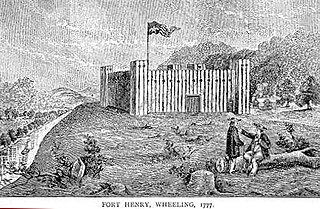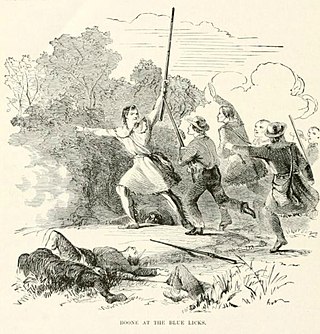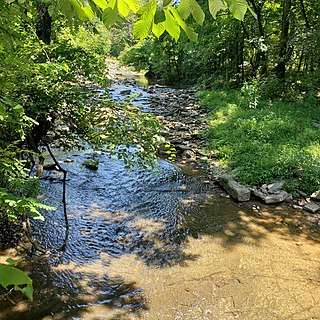
Marshall County is a county in the U.S. state of West Virginia. At the 2020 census, the population was 30,591. Its county seat is Moundsville. With its southern border at what would be a continuation of the Mason-Dixon line to the Ohio River, it forms the base of the Northern Panhandle of West Virginia.

Wheeling is a city in the U.S. state of West Virginia. Located almost entirely in Ohio County, of which it is the county seat, it lies along the Ohio River in the foothills of the Appalachian Mountains and also contains a tiny portion extending into Marshall County. Wheeling is located about 60 miles (96 km) west of Pittsburgh and is the principal city of the Wheeling metropolitan area. As of the 2020 census, the city had a population of 27,062, and the metro area had a population of 139,513. It is the fifth-largest city in West Virginia, and the largest in the state’s Northern Panhandle.

Lord Dunmore's War, also known as Dunmore's War, was a brief conflict in fall 1774 between the British Colony of Virginia and the Shawnee and Mingo in the trans-Appalachian region of the colony south of the Ohio River. Broadly, the war included events between May and Oct., 1774. The governor of Virginia during the conflict was John Murray, 4th Earl of Dunmore, who in May, 1774, asked the House of Burgesses to declare a state of war with the Indians and call out the Virginia militia.

Fort Henry was a colonial fort which stood about ¼ mile from the Ohio River in what is now downtown, Wheeling, West Virginia. The fort was originally known as Fort Fincastle and was named for Viscount Fincastle, Lord Dunmore, Royal Governor of Virginia. Later it was renamed for Patrick Henry, and was at the time located in Virginia. The fort was subject to two major sieges, two notable feats and other skirmishes.

The Battle of Blue Licks, fought on August 19, 1782, was one of the last battles of the American Revolutionary War. The battle occurred ten months after Lord Cornwallis's surrender at Yorktown, which had effectively ended the war in the east. On a hill next to the Licking River in what is now Robertson County, Kentucky, a force of about 50 Loyalists along with 300 indigenous warriors ambushed and routed 182 Kentucky militiamen, who were partially led by Daniel Boone. It was the last victory for the Loyalists and natives during the frontier war. British, Loyalist and Native forces would engage in fighting with American forces once more the following month in Wheeling, West Virginia, during the Siege of Fort Henry.
Lewis Wetzel was an American scout, frontiersman, and killer of Native Americans. Raised in what is now the Northern Panhandle of West Virginia, his exploits once hailed as similar to those of Daniel Boone.

Ebenezer Zane was an American pioneer, soldier, politician, road builder and land speculator. Born in the Colony of Virginia, Zane established a settlement near Fort Henry which became Wheeling, on the Ohio River. He also blazed an early road through the Ohio Country to Limestone known as Zane's Trace.

The western theater of the American Revolutionary War (1775–1783) was the area of conflict west of the Appalachian Mountains, the region which became the Northwest Territory of the United States as well as what would become the states of Kentucky, Tennessee, Missouri, and Spanish Louisiana. The western war was fought between American Indians with their British allies in Detroit, and American settlers south and east of the Ohio River, and also the Spanish as allies of the latter.
Thomas Bullitt was a United States military officer from Prince William County, Virginia and pioneer on its western frontier.

The U.S. state of West Virginia was formed out of western Virginia and added to the Union as a direct result of the American Civil War, in which it became the only modern state to have declared its independence from the Confederacy. In the summer of 1861, Union troops, which included a number of newly formed Western Virginia regiments, under General George McClellan, drove off Confederate troops under General Robert E. Lee. This essentially freed Unionists in the northwestern counties of Virginia to form a functioning government of their own as a result of the Wheeling Convention. Prior to the admission of West Virginia the government in Wheeling formally claimed jurisdiction over all of Virginia, although from its creation it was firmly committed to the formation of a separate state.

Lochry's Defeat, also known as the Lochry massacre, was a battle fought on August 24, 1781, near present-day Aurora, Indiana, in the United States. The battle was part of the American Revolutionary War (1775–1783), which began as a conflict between Great Britain and the Thirteen Colonies before spreading to the western frontier, where American Indians entered the war as British allies. The battle was short and decisive: about one hundred Indians of local tribes led by Joseph Brant, a Mohawk military leader who was temporarily in the west, ambushed a similar number of Pennsylvania militiamen led by Archibald Lochry. Brant and his men killed or captured all of the Pennsylvanians without suffering any casualties.

Samuel Ross Mason, also spelled Meason, was a Virginia militia captain, on the American western frontier, during the American Revolutionary War. After the war, he became the leader of the Mason Gang, a criminal gang of river pirates and highwaymen on the lower Ohio River and the Mississippi River in the late 18th and early 19th centuries. He was associated with outlaws around Red Banks, Cave-in-Rock, Stack Island, and the Natchez Trace.
Belleville is an unincorporated community in Wood County, West Virginia, United States. Its elevation is 594 feet (181 m).
Captain William Foreman was a colonial American officer from Hampshire County, Virginia, who was killed during an Indian ambush at the McMechen Narrows on the Ohio River south of Wheeling, Virginia in 1777.

McColloch's Leap was a feat performed during a September 1777 attack by Native Americans on Fort Henry, site of present-day Wheeling, West Virginia, during the American Revolutionary War. While escaping a Native American warband, American frontiersman Samuel McColloch rode his horse down a dangerously high and steep drop. Both he and his horse survived without injury. The leap is based on a historic event, but retellings have exaggerated the story into a local legend or tall tale.

Thomas Gaddis (1742–1834) was a militia officer in the American Revolutionary War. He was born December 28, 1742, in Winchester, Frederick County, Virginia and married Hannah Rice in 1764; the same year he built Fort Gaddis, a refuge from the Indians, located on the Catawba Trail. In fact, Pennsylvania and Virginia had conflicting claims in the area Gaddis settled. Though he maintained his loyalty to Virginia, Gaddis also protected his investment by recording his patent with Pennsylvania authorities. By 1773, both states created new geo-political boundaries in recognition of increased white settlement. Pennsylvania formed Westmoreland County out of the larger Bedford County, and Virginia established the District of West Augusta. In 1776, West Augusta was further divided into three counties: Ohio, Yohogania, and Monongalia, where Gaddis and his family resided.
Fort Forman was a stockade fort erected by Captain William Foreman at the beginning of the French and Indian War situated three miles north of Romney on the South Branch Potomac River near Vance on West Virginia Route 28. Fort Furman was in use from its construction in 1755 until 1764.

The second siege of Fort Henry took place from September 11 to 13, 1782, during the American Revolutionary War. A force of about 300 Wyandot, Shawnee, Seneca and Lenape laid siege to Fort Henry, an American outpost at what is now Wheeling, West Virginia, accompanied by a force of 50 Loyalist soldiers from Butler's Rangers, a provincial military unit. The siege is commonly known as "The Last Battle of the Revolutionary War," despite subsequent skirmishes between Patriots and Loyalists involving the loss of life taking place in New Jersey later in 1782. However, these were unorganized outbreaks of fighting between patrons with opposing sentiments rather than engagements between sovereign powers and their allies.

Angus McDonald was a prominent Scottish American military officer, frontiersman, sheriff and landowner in Virginia.

Thomas Glenn was among the first pioneers to venture into the Western Virginia and Kentucky territories. He was born in 1750 in present-day Pennsylvania, married before 1770 and settled in present-day Wheeling, West Virginia by 1774, but possibly earlier. He was part of an advanced detachment of John Floyd's survey expedition before joining James Harrod's party in founding Harrodstown, the earliest permanent white settlement west of the Appalachians, along with his younger brother David Glenn. Together they explored a large portion of Kentucky in the 1770s making several improvements from Frankfort down to Russell Springs.















